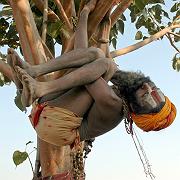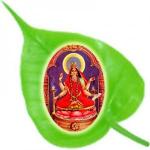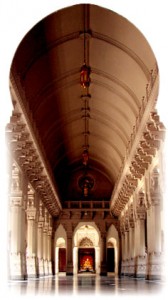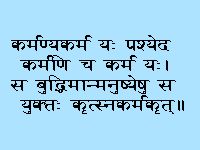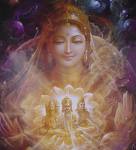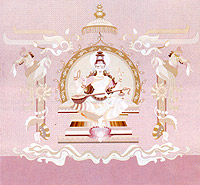Search results for bhagavad gita (50)
navagraha – neun Planeten
Wirkende Kräfte
Die neun Planeten sind die eigentlichen Akteure, die Wirkung hervorbringenden Kräfte im Horoskop. Der Charakter und das Schicksal eines Menschen werden in Jyotish entsprechend der Stellung am Himmel beschrieben, den die Planeten im Moment der Geburt, vom Ort der Geburt aus gesehen, einnehmen. Da die Planeten in der Astrologie relativ zu einem bestimmten Ort auf der Erde betrachtet werden und sie sich aus der Perspektive dieses Ortes über den Himmel „bewegen“, werden sie alle als Planeten bezeichnet – „Planet“ bedeutet wörtlich „der Umherschweifende“. Anders als in der Astronomie werden daher Sonne und Mond ebenso wie die beiden Mondknoten in der Astrologie als Planeten bezeichnet.
…Listen, O Devi,
I will speak concisely of the essence of yoga.
The body resembles a tree, with the root above and the branches below.
In the macrocosm there are tirthas (bathing places) which also exist in the body.
The macrocosm is like the microcosm.
Todala Tantra, II.
![]()
He’s there among the scented TREE´s,
playing the notes he has taught you.
Too late for embarrassment, shy doe
nibbling at the forest’s edge,
shawled in deep blue shadows.
He’s calling you. The flower of your soul
is opening, little deer.
The river of scent will lead you
deep into the trees where he waits.
The bihanga also plays tonight —
do you hear his more distant flute?
Black bees carry the moon’s luster
from flower to flower.
The rest of the grove will bloom tonight, I think.
How he looks at you, young animal.
He shames the moon with his own dark light.
Let’s bow down before the young Lord,
the deep blue flowers at his feet.
Rabindranath Tagore
![]()
THE EVERGREEN TREE:
Most noble
evergreen with your roots
in the sun:
you shine in the cloudless
sky of a sphere no earthly
eminence can grasp,
enfolded in the clasp
of ministries divine.
You blush like the dawn,
you burn like a flam
of the sun.
Hildegard of Bingen
![]()
When in the evening the full moon gets caught up
Among the twigs of the Kadam tree
Can anyone catch it
And pick it up for me?
When I only asked this my brother laughed at me,
‘O boy! a more foolish fellow could there be?
How can one touch it
For it is so far away from the earth.’
I told him, ‘You know nothing,
When mum smiles at me from the window
Is she so far from me?’
Yet my brother tells me,
‘A more foolish fellow I am yet to see.
Also he tells me,
Where will you get a trap so big?’
I tell him, ‘It is so small
You don’t need any trap at all
Just clasp it in your palms, that’s all.’
‘Mum, why my brother calls me a fool
When he tells me, ‘If the moon came closer
You could see how big it is.
But I tell him, ‘What rubbish you study in school,
When mum comes closer to kiss me
Does she look so big?’
Yet my brother tells me
A more foolish fellow he is yet to see.
“ Astronomy „
Original in Bengali – Jyotish-Shastra by Rabindranath Tagore
by Kumud Biswas
![]()
> Bhagavad Gita As It Is — Get Your Own Copy <
Chapter 15. The Yoga of the Supreme Person
TEXT 1
sri-bhagavan uvaca
urdhva-mulam adhah-sakham
asvattham prahur avyayam
chandamsi yasya parnani
yas tam veda sa veda-vit
SYNONYMS
sri-bhagavan uvaca–the Supreme Personality of Godhead said; urdhva-mulam–with roots above; adhah–downwards; sakham–branches; asvattham–banyan tree; prahuh–said; avyayam–eternal; chandamsi–Vedic hymns; yasya–of which; parnani–the leaves; yah–anyone; tam–that; veda–knows; sah–he; veda-vit–the knower of the Vedas.
TRANSLATION
The Blessed Lord said: There is a banyan tree which has its roots upward and its branches down and whose leaves are the Vedic hymns. One who knows this tree is the knower of the Vedas.
![]()
IN OUR TALONS – Dead Oceans :
And the warblers sing:
deet-deet-deet-deet-deet-deet-deet-deet-deet-deet!
And the sparrows sing:
deet-deet-deet-deet-deet-deet-deet-deet-deet-deet!
Through the wheels, through the wheels on the interstate,
And hear no refrain.
And the beetles creep
(deet-deet-deet-deet-deet-deet-deet-deet-deet-deet!)
On the crippled trees,
(deet-deet-deet-deet-deet-deet-deet-deet-deet-deet!)
And they look down to where the soil must have been, wondering.
And no, youre not alone. No, my cousins, youre not alone.
Youre in our talons now, and were never letting go.
And the branches bend
(deet-deet-deet-deet-deet-deet-deet-deet-deet-deet!)
To the growing sea.
(deet-deet-deet-deet-deet-deet-deet-deet-deet-deet!)
And they ask, and they ask it to spread their seeds,
For they know theyre drowning.
And no, youre not alone. No, my cousins, youre not alone.
Youre in our talons now, and were never letting go.
Youre in our headlights, frozen, and no, were not stopping
You may not believe, but even we were scared at first.
It takes a lot of nerve to destroy this wondrous earth.
Were only human; this at least weve learned
![]()
A MOTH SPORTS BY CANDLE LIGHT
AS PINE TREES bend beneath the pile of snow,
So shall I kneel before your mighty power,
This sunset eve, this solemn silent hour.
Midget ‚me‘ yields! only now do I know
That I must die for angel wings to grow.
In one ultramarine wave of bliss, our
Hearts are blent beneath the marriage bower,
To fuse in a lantern’s incandescent glow.
Consumed by fierce naked white hot flame,
Like a moth who flies too near the light,
Bewildered, blazing, brilliantly bright,
Mind’s flint is struck with reverence for your Name.
My eyes can no more bear this dazzling sight,
‚I Am That‘, by your Grace, eternally the same!
Alan Jacobs – Poet/Writer/Author
![]()
Just as a tree, though cut down, can grow again and again if its roots are undamaged and strong, in the same way if the roots of craving are not wholly uprooted sorrows will come again and again.
~The Dhammapada~
![]()
„All religions, arts and sciences are branches of the same tree.
All these aspirations are directed toward ennobling man’s life, lifting it from the sphere of mere physical existence and leading the individual towards freedom.“
Albert Einstein
![]()
> ~ The Ancient Tree…Osho ~ <
I have heard that there was once an ancient and majestic tree, with branches spreading out towards the sky. When it was in a flowering mood, butterflies of all shapes, colors and sizes danced around it. When it grew blossoms and bore fruit, birds from far lands came and sang in it. The branches, like outstretched hands, blessed all who came and sat in their shade. A small boy used to come and play under it, and the big tree developed an affection for the small boy.
Love between big and small is possible, if the big is not aware that it is big. The tree did not know it was big; only man has that kind of knowledge. The big always has the ego as its prime concern, but for love, nobody is big or small. Love embraces whomsoever comes near.
So the tree developed a love for this small boy who used to come to play near it. Its branches were high, but it bent and bowed them down so that he might pluck its flowers and pick its fruit.
Love is ever ready to bow; the ego is never ready to bend. If you approach the ego, its branches will stretch upwards even more; it will stiffen so you cannot reach it.
The playful child came, and the tree bowed its branches. The tree was very pleased when the child plucked some flowers; its entire being was filled with the joy of love. Love is always happy when it can give something; the ego is always happy when it can take.
The boy grew. Sometimes he slept on the tree’s lap, sometimes he ate its fruit, and sometimes he wore a crown of the tree’s flowers and acted like a jungle king. One becomes like a king when the flowers of love are there, but one becomes poor and miserable when the thorns of the ego are present. To see the boy wearing a crown of flowers and dancing about filled the tree with joy. It nodded in love; it sang in the breeze. The boy grew even more. He began to climb the tree to swing on its branches. The tree felt very happy when the boy rested on its branches. Love is happy when it gives comfort to someone; the ego is only happy when it gives discomfort.
With the passage of time the burden of other duties came to the boy. Ambition grew; he had exams to pass; he had friends to chat with and to wander about with, so he did not come often. But the tree waited anxiously for him to come. It called from its soul, „Come. Come. I am waiting for you.“
Love waits day and night. And the tree waited. The tree felt sad when the boy did not come. Love is sad when it cannot share; love is sad when it cannot give. Love is grateful when it can share. When it can surrender, totally, love is the happiest.
As he grew, the boy came less and less to the tree. The man who becomes big, whose ambitions grow, finds less and less time for love. The boy was now engrossed in worldly affairs.
One day, while he was passing by, the tree said to him, „I wait for you but you do not come. I expect you daily.“
The boy said, „What do you have? Why should I come to you? Have you any money? I am looking for money.“ The ego is always motivated. Only if there is some purpose to be served will the ego come. But love is motiveless. Love is its own reward.
The startled tree said, „You will come only if I give something?“ That which withholds is not love. The ego amasses, but love gives unconditionally. „We don’t have that sickness, and we are joyful,“ the tree said. „Flowers bloom on us. Many fruits grow on us. We give soothing shade. We dance in the breeze, and sing songs. Innocent birds hop on our branches and chirp even though we don’t have any money. The day we get involved with money, we will have to go to the temples like you weak men do, to learn how to obtain peace, to learn how to find love. No, we do not have any need for money.“
The boy said, „Then why should I come to you? I will go where there is money. I need money.“ The ego asks for money because it needs power.
The tree thought for a while and said, „Don’t go anywhere else, my dear. Pick my fruit and sell it. You will get money that way.“
The boy brightened immediately. He climbed up and picked all the tree’s fruit; even the unripe ones were shaken down. The tree felt happy, even though some twigs and branches were broken, even though some of its leaves had fallen to the ground. Getting broken also makes love happy, but even after getting, the ego is not happy. The ego always desires more. The tree didn’t notice that the boy hadn’t even once looked back to thank him. It had had its thanks when the boy accepted the offer to pick and sell its fruit.
The boy did not come back for a long time. Now he had money and he was busy making more money from that money. He had forgotten all about the tree. Years passed. The tree was sad. It yearned for the boy’s return — like a mother whose breasts are filled with milk but whose son is lost. Her whole being craves for her son; she searches madly for her son so he can come to lighten her. Such was the inner cry of that tree. Its entire being was in agony.
After many years, now an adult, the boy came to the tree.
The tree said, „Come, my boy. Come embrace me.“
The man said, „Stop that sentimentality. That was a childhood thing. I am not a child any more.“ The ego sees love as madness, as a childish fantasy.
But the tree invited him: „Come, swing on my branches. Come dance. Come play with me.“
The man said, „Stop all this useless talk! I need to build a house. Can you give me a house?“
The tree exclaimed: „A house! I am without a house.“ Only men live in houses. Nobody else lives in a house but man. And do you notice his condition after his confinement among four walls? The bigger his buildings, the smaller man becomes. „We do not stay in houses, but you can cut and take away my branches — and then you may be able to build a house.“
Without wasting any time, the man brought an axe and severed all the branches of the tree. Now the tree was just a bare trunk. But love cares not for such things — even if its limbs are severed for the loved one. Love is giving; love is ever ready to give.
The man didn’t even bother to thank the tree. He built his house. And the days flew into years.
The trunk waited and waited. It wanted to call for him, but it had neither branches nor leaves to give it strength. The wind blew by, but it couldn’t even manage to give the wind a message. And still its soul resounded with one prayer only: „Come. Come, my dear. Come.“ But nothing happened.
Time passed and the man had now become old.
Once he was passing by and he came and stood by the tree.
The tree asked, „What else can I do for you? You have come after a very, very long time.“
The old man said, „What else can you do for me? I want to go to distant lands to earn more money. I need a boat, to travel.“
Cheerfully, the tree said, „But that’s no problem, my love. Cut my trunk, and make a boat from it. I would be so very happy if I could help you go to faraway lands to earn money. But, please remember, I will always be awaiting your return.“
The man brought a saw, cut down the trunk, made a boat and sailed away.
Now the tree is a small stump. And it waits for its loved one to return. It waits and it waits and it waits. The man will never return; the ego only goes where there is something to gain and now the tree has nothing, absolutely nothing to offer. The ego does not go where there is nothing to gain. The ego is an eternal beggar, in a continuous state of demand, and love is charity. Love is a king, an emperor! Is there any greater king than love?
I was resting near that stump one night. It whispered to me, „That friend of mine has not come back yet. I am very worried in case he might have drowned, or in case he might be lost. He may be lost in one of those faraway countries. He might not even be alive any more. How I wish for news of him! As I near the end of my life, I would be satisfied with some news of him at least.
Then I could die happily. But he would not come even if I could call him. I have nothing left to give and he only understands the language of taking.“
The ego only understands the language of taking; the language of giving is love.
I cannot say anything more than that. Moreover, there is nothing more to be said than this: if life can become like that tree, spreading its branches far and wide so that one and all can take shelter in its shade, then we will understand what love is. There are no scriptures, no charts, no dictionaries for love. There is no set of principles for love.
I wondered what I could say about love! Love is so difficult to describe. Love is just there. You could probably see it in my eyes if you came up and looked into them. I wonder if you can feel it as my arms spread in an embrace.
Love.
What is love?
If love is not felt in my eyes, in my arms, in my silence, then it can never be realized from my words.
I am grateful for your patient hearing. And finally, I bow to the Supreme seated in all of us.
Please accept my respects.
EXCERPT FROM THE GENESIS OF LOVE -OSHO
Osho Aakash Krishna
![]()
-: Value of a Tree :-
It depends, you may say- A sandal wood tree may be worth lakhs and an Acacia tree may be worth just a few thousands. Be it a sandal wood or Acacia, every tree is worth a whopping Rs.33 lakhs. A tree lives for 50 years. Generates Rs.5.5 lakhs worth of oxygen. Rs.6.4 lakhs worth of soil fertility. Facilitates Rs.6.4 lakhs worth of soil erosion control. Creates Rs.10.5 lakhs worth of air pollution control. Provides Rs.5.3 lakhs worth of shelter for birds and animals. A fully grown tree, irrespective of genus & specie produces as much oxygen per day, as is sufficient for 200 persons for one week.
From D’Souza Wilberious Evanglist
Wie ein Baum, ein Herr des Wald´s
So, wahrlich, ist der Mensch (purusha)
Seine Haare sind die Blätter,
seine Haut die äuß´re Borke.
Wirklich, Blut tropft aus seiner Haut,
wie Harz tropft aus den Rinden.
Drum, wenn die Haut verletzt,
tritt Blut hervor,
wie´s Harz aus dem verletzten Baum.
Sein Fleisch ist gleich der inn´ren Rindenschicht,
die Sehnen gleich der zähen Schicht darunter.
Da darunter sind die Knochen, die dem Holze gleichen.
Das Knochenmark ist wie des Baumes Kern.
Wenn nun ein Baum, nachdem gefällt,
aus seiner Wurzel neu wächst in einen and´ren,
aus welcher Wurzel wachset dann der Sterbliche,
wenn er vom Tod dahingestreckt?
Sag nicht, „vom Samen”,
denn der wird nur im Lebenden hervorgebracht.
Tatsächlich wächst der Baum aus Samen;
Nach seinem Tod sprießt er erneut.
Doch wenn der Baum samt all seiner Wurzeln
vernichtet, sprießt er nicht erneut hervor.
Aus welcher Wurzel wachset dann der Sterbliche,
wenn er vom Tod dahingestreckt?
Er wird einfach geboren (und stirbt dann,
kann man sagen.) Doch nein (sag ich)!
Er wird erneut geboren. Woraus geboren?
Aus dem Bewussten, glücksel´gen brahman,
seiner Zuflucht, die er kennt, in der er weilt.
Brihad Aryanka Upanishad (3.9.28.1-7)
O vos felices radices
O you, happy roots,
with whom works of miracles
and not works of crime,
for burning predestined you were planted.
And to you, thoughtful fiery voice,
becoming the whetstone,
subverting the darkness.
Rejoice in that which is on top.
Rejoice in him,
who the many did not see on earth,
although they ardently cried for.
Rejoice in that which is on top.
O vos felices radices
cum quibus opus miraculorum,
et no opus criminum,
per torrens iter perspicuae umbrae plantum est.
Et o tu, ruminams ignea vox,
praecurrens liminatem lapidem,
subvertentem abyssum,
gaudete in capite vestro.
Gaudete in ilio,
quem no viderunt in terris multi,
qui ipsum ardenter vocaverunt.
Gaudete in capite vestro.
Hildegard von Bingen (1098 – 1179)
My Tree Self
stand
firmly as an oak
unimpeded
by the winds of life.
My arms reach
upward
like a noble sequoia
yearning for the light.
I abide
in patient silence,
all time banished.
No thoughts or images
disturb the stillness
of my mind.
My breath rises from
the ground to the heavens,
and carries my spirit
to the luminous realms
where all beings
are one-tree, Earth, and I.
by Georg Feuerstein
> About BKS MANAOYOGA COCONUT TREE LOGO <
HERMANN HESSE über Bäume:
Bäume sind für mich immer die eindringlichsten Prediger gewesen. Ich verehre sie, wenn sie in Völkern und Familien leben, in Wäldern und Hainen. Und noch mehr verehre ich sie, wenn sie einzeln stehen. Sie sind wie Einsame. Nicht wie Einsiedler, welche aus irgendeiner Schwäche sich davongestohlen haben, sondern wie große, vereinsamte Menschen, wie Beethoven und Nietzsche. In ihren Wipfeln rauscht die Welt, ihre Wurzeln ruhen im Unendlichen; allein sie verlieren sich nicht darin, sondern erstreben mit aller Kraft ihres Lebens nur das Eine: ihr eigenes, in ihnen wohnendes Gesetz zu erfüllen, ihre eigene Gestalt auszubauen, sich selbst darzustellen. Nichts ist heiliger, nichts ist vorbildlicher als ein schöner, starker Baum …
Ein Baum spricht: In mir ist ein Kern, ein Funke, ein Gedanke verborgen, ich bin Leben vom ewigen Leben. Einmalig ist der Versuch und Wurf, den die ewige Mutter mit mir gewagt hat, einmalig ist meine Gestalt und das Geäder meiner Haut, einmalig das kleinste Blätterspiel meines Wipfels und die kleinste Narbe meiner Rinde. Mein Amt ist es, im ausgeprägten Einmaligen das Ewige zu gestalten und zu zeigen.
Ein Baum spricht: Meine Kraft ist das Vertrauen. Ich weiß nichts von meinen Vätern, ich weiß nichts von den tausend Kindern, die in jedem Jahr aus mir entstehen. Ich lebe das Geheimnis meines Samens zu Ende, nichts andres ist meine Sorge. Ich vertraue, daß Gott in mir ist. Ich vertraue, daß meine Aufgabe heilig ist. Aus diesem Vertrauen lebe ich.
Wenn wir traurig sind und das Leben nicht mehr gut ertragen können, dann kann ein Baum zu uns sprechen:
Sei still! Sei still! Sieh mich an! Leben ist nicht leicht, Leben ist nicht schwer. Das sind Kindergedanken. Laß Gott in dir reden, so schweigen sie. Du bangst, weil dich dein Weg von der Mutter und Heimat wegführt. Aber jeder Schritt und Tag führt dich neu der Mutter entgegen. Heimat ist nicht da oder dort. Heimat ist in dir innen, oder nirgends.
Wandersehnsucht reißt mir am Herzen, wenn ich Bäume höre, die abends im Wind rauschen. Hört man still und lange zu, so zeigt auch die Wandersehnsucht ihren Kern und Sinn. Sie ist nicht Fortlaufenwollen vor dem Leide, wie es schien. Sie ist Sehnsucht nach Heimat, nach Gedächtnis der Mutter, nach neuen Gleichnissen des Lebens. Sie führt nach Hause. Jeder Weg führt nach Hause, jeder Schritt ist Geburt, jeder Schritt ist tod, jedes Grab ist Mutter …
Wer gelernt hat, Bäumen zuzuhören, begehrt nicht mehr, ein Baum zu sein.
Er begehrt nichts zu sein, als was er ist.
Das ist Heimat. Das ist Glück.
Hermann Hesse
Cafe-Gespräch am 18.6. mit Shri Sarvabhavana in Berlin-Tiergarten
Liebe Vedic-Guide Freunde,
wir freuen uns, Sie über die kommende Veranstaltung in Berlin zu informieren und einzuladen:
CAFE-GESPRÄCHE – PHILOSOPHISCHE VORTRÄGE ÜBER DIE PROBLEME DES MODERNEN MENSCHEN
Die Themen dieser Vortragsreihe befassen sich mit allen Facetten und Nöten unserer häufig verworrenen und richtungslosen Existenz in der heutigen, modernen Zeit. Shri Sarvabhavana gibt uns Antworten, die auf den Weisheiten der altindischen, vedischen Schriften basieren. Er vermittelt uns auf eine eindeutige und geradlinige Weise, wie wir diese ewig gültigen Prinzipien verstehen und leben können.
Eintritt auf Spendenbasis
iii
Advaita Vedanta – Vivekananda, Ramakrishna
www.ramakrishnavivekananda.info
www.vedantasociety-chicago.org
Dakshineswar Ramkrishna Sangha Adyapeath – In 1915, a young Brahmin named Annada Charan Bhattacharya was setting up a successful practice in Ayurvedic medicine in Calcutta. A capable scientist, he had discovered seven patent medicines and went on to become a renowned doctor all over Bengal.
Sri Ramakrishna Paramahamsa (Bangla: রামকৃষ্ণ পরমহংস Ramkṛiṣṇo Pôromôhongśo) (February 18, 1836 – August 16, 1886), born Gadadhar Chattopadhyay (Bangla: গদাধর চট্টোপাধ্যায় Gôdadhor Chôţţopaddhae), was a famous mystic of 19th-century India. His religious school of thought led to the formation of the Ramakrishna Mission by his chief disciple Swami Vivekananda – both were influential figures in the Bengali Renaissance as well as the Hindu renaissance during the 19th and 20th centuries.Many of his disciples and devotees believe he was an avatar or incarnation of God. Ramakrishna was born in a poor Brahmin Vaishnava family in rural Bengal. He became a priest of the Dakshineswar Kali Temple, dedicated to the goddess Kali, which had the influence of the main strands of Bengali bhakti tradition. Read More: > HERE <
Ramakrishna Math and Ramakrishna Mission are twin organizations which form the core of a worldwide spiritual movement (known as Ramakrishna Movement or Vedanta Movement), which aims at the harmony of religions, harmony of the East and the West, harmony of the ancient and the modern, spiritual fulfillment, all-round development of human faculties, social equality, and peace for all humanity, without any distinctions of creed, caste, race or nationality.
RAMAKRISHNA MATH is a monastic organization for men brought into existence by Sri Ramakrishna (1836-1886), the great 19th century saint of Bengal who is regarded as the Prophet of the Modern Age.
RAMAKRISHNA MISSION is a registered society in which monks of Ramakrishna Math and lay devotees cooperate in conducting various types of social service mainly in India. It was founded by Sri Ramakrishna chief apostle, > SWAMI VIVEKANANDA (vedanta, jnana yoga )< (1863-1902), one of the foremost thinkers and religious leaders of the present age, who is regarded as ‚one of the main moulders of the modern world‘, in the words of an eminent Western scholar A. L. Basham.
The ideology of Ramakrishna Math and Mission consists of the eternal principles of Vedanta as lived and experienced by Sri Ramakrishna and expounded by Swami Vivekananda. This ideology has three characteristics: it is modern in the sense that the ancient principles of Vedanta have been expressed in the modern idiom; it is universal, that is, it is meant for the whole humanity; it is practical in the sense that its principles can be applied in day-to-day life to solve the problems of life.
The motto of Ramakrishna Math and Ramakrishna Mission is: Atmano mokshartham jagad hitaya cha, „For one’s own salvation, and for the welfare of the world“. The main goals and objectives of these twin organizations, based on the principles of Practical Vedanta, are:
- To spread the idea of the potential divinity of every being and how to manifest it through every action and thought.
- To spread the idea of harmony of religions based on Sri Ramakrishna’s experience that all religions lead to the realization of the same Reality known by different names in different religions. The Mission honours and reveres the founders of all world religions such as Buddha, Christ and Mohammed.
- To treat all work as worship, and service to man as service to God.
- To make all possible attempts to alleviate human suffering by spreading education, rendering medical service, extending help to villagers through rural development centres, etc.
- To work for the all-round welfare of humanity, especially for the uplift of the poor and the downtrodden.
- To develop harmonious personalities by the combined practice of Jnana, Bhakti, Yoga and Karma.
Sarada Devi (Bengali: সারদা দেবী) (1853—1920), born Saradamani Mukhopadhyaya, was the wife and spiritual counterpart of Ramakrishna Paramahamsa, a nineteenth century mystic of Bengal. Sarada Devi is also reverentially addressed as the Holy Mother (Sri Maa) by the followers of the Ramakrishna monastic order. Sarada Devi played an important role in the growth of the Ramakrishna Movement. Read More: > HERE <
Endearingly known as ‘Holy Mother’, Sri Sarada Devi, the spiritual consort of Sri Ramakrishna, was born on 22 December 1853 in a poor Brahmin family in Jayrambati, a village adjoining Kamarpukur in West Bengal. Her father, Ramachandra Mukhopadhyay, was a pious and kind-hearted person, and her mother, Shyama Sundari Devi, was a loving and hard-working woman.
-
COMPLETE WORK OF RAMAKRISHNA AND VIVEKANANDA (free) downloads: www.ramakrishnavivekananda.info
-
Swami Vivekananda´s > SPEECH AT CHICAGO < at the PARLIAMENT OF WORLDRELIGIONS at Chicago in 1893.
- Read Fundamental Concepts of Vedanta here:
Sripad Vaiyasaki Das & the Kirtan Explosion Band
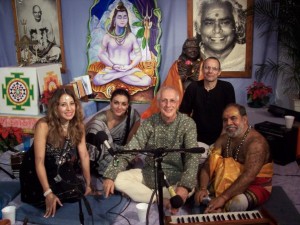
www.bhaktivedantahospital.com www.barsanaeyecamp.com
http://en.wikipedia.org/wiki/Bhakti_Yoga
Internationally recognized for his musical abilities to perform the ancient kirtan songs, Vaiyasaki Das approaches kirtan and devotional music from the ancient Vedic tradition of India. Vaiyasaki, who is an initiated disciple of Bhaktivedanta Swami, spent many years in India and Bangladesh learning the ragas inherent to the various kirtan styles from the best kirtan musicians and singers. Since the ’70s he has performed in 61 countries, recorded 12 CDs, and written a book how the kirtan/yoga culture was transplanted to the West. He has been a practitioner of bhakti yoga for 34 years and performs his music with a mission to uplift the consciousness of the planet. His considerable knowledge of the vast repertoire of Indian bhajans has provided the foundation for a new generation of artists, in the flourishing genre of music for yoga and mantra meditation.
ABOUT THE ARTIST: Internationally recognized for his musical abilities to perform the ancient art form of Kirtan & Bhajan, Vaiyasaki Das provides a rare opportunity to experience a taste of authentic devotional music from the Vedic tradition. Though born in London, England, Vaiyasaki Das came of age in Winnipeg, Canada. After many years in the music business – and a personal search for the divine — he is now one of the premier singers on the kirtan circuit. Starting out as a rock and blues guitarist with a penchant for singing, his taste for Indian culture came at an early age.
Sripad Vaiyasaki Das
Freitag 23. April 17.00–19.00
Sonntag 25. April 17.00–18.00
Verein für Hindu-Gaudiya-Vaisnavas
Wienerbergstraße 29a/Top3, 1120 Wien, Österreich
By 1970, he found himself back in London and enamored by Krishna devotion. Soon, in 1973, he was committed to the path of devotion, or bhakti-yoga, and, just two years later, he received formal initiation from > His Divine Grace A. C. Bhaktivedanta Swami <. On his Guru’s request he journeyed to India in 1975, both for personal purification and to proclaim the renaissance of Sri Chaitanya Mahaprabhu’s bhakti movement. He traveled the entire subcontinent, and Southeast Asia, serving the mission of bhakti-yoga.
By 1978, he arrived in Bangladesh, where he imbibed the culture through his pores, becoming fluent in Bengali and learning the ways of the local people. On a boat trip down the Meghna River, he chanced upon a local kirtan band on their way to a festival. Deciding to follow these happy minstrels and their soulful kirtan music, he would also attend that same festival, changing his life forever. It was there that he discovered the ancient Bengali art of raga-kirtan, which touched his soul in the deepest possible way. Never before had he heard such angelic singing, and he resolved to use his own considerable vocal talents to spread this technique around the world.
He returned to London with his own style of kirtan, a blend of ancient Bengali and modern contemporary music. His first album was released in 1982 followed by numerous CDs, which are now considered seminal in the yoga/kirtan/world music universe. Today Vaiyasaki Das is a much sought-after performer, conducting workshops and leading yoga festivals and retreats worldwide. Sharing his heart through music and chanting is the basis of his life.
He has been a practitioner of bhakti yoga for 34 years and performs his music with a mission to uplift the consciousness of the planet. His considerable knowledge of the vast repertoire of Indian bhajans and kirtans has provided the foundation for a new generation of artists, in the flourishing genre of music for yoga and mantra meditation.
His CDs include: The Way of Love, Charana Kamal, Kirtan Rasa, Hari-Nam-Ananda, Transcendence, Vrindavan Chandra, Chaitanya Chandra, Ratha-Yatra USA, The Turning Point, Best of Vaiyasaki, Kirtan Explosion – High energy kirtans, & Sri Krishna Divya Nam.
- www.bhagavad-gita.org
- www.srimadbhagavatam.org (Bhagavata Purana)
- ISKCON – BHAKTIVEDANTA, BHAKTI YOGA <
- Bhaktivedanta, Share your Care, Eye Camp <
- VEDA, TREE´s AND THE HOLY SCRIPTURES <
- What is Bhakti Yoga ? <
- Die Vedische Kochkunst <
- Die Veden, Puranas, UNESCO Publishing, FREE downloads <
- UNESCO – The Tradition of Vedic Chanting <
- ISKCON Desire Tree, free downloads <
- Meet Srila Prabhupada – A. C. Bhaktivedanta Swami, studies, friends fans at fb <
- Meet Vaiyasaki Das & the Kirtan Explosion Band, friends fans at fb <
- Meet Hindus in Austria, friends, fans at fb <
Researches in Indian and Buddhist Philosphy
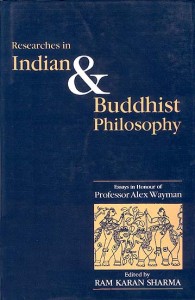
> Chap16: Comp. Siddis in Bhagavata Purana & Patanjali Yoga Sutras <
> BOOK: SIDDHIS IN THE BHAGAVAD PURANA <
Siddhi (Devnagari सिद्धि) is a Sanskrit noun that can be translated as „perfection“, „accomplishment“, „attainment“, or „success“. The term is first attested in the Mahabharata. In the Pancatantra, a siddhi may be any unusual skill or faculty or capability. As a legal term in the Manusmriti, it refers to the settlement of a debt.
In the Samkhya Karika and Tattva Samasa, and hence in Tantric Buddhism, it specifically refers to the acquisition of supernatural powers by magical means or the supposed faculty so acquired. These powers include items such as clairvoyance, levitation, to be present at various different places simultaneously, to become as small as an atom, to materialize objects, to have access to memories from past lives, etc. The term is also used in this sense in the Sarvadarsana-samgraha of Madhvacharya. Read More: > HERE <
Researches in Indian and Buddhist philosophy:
Essays in honour of Professor Alex Wayman, RÄ�ma Karaṇa ŚarmÄ�
The present volume, comprising ninteen articles by renowned scholars, is divided into three sections, namely, Buddhist Jaina and Hindu Philsosphical Researches. The articles in Hindu section take a comperative base. K.K.Raj compares the Buddhist and Mimamsa views on Laksana. K. Bhattacharya speaks of grammarians and philososphers regarding post-Panini grammarians on a certain anusasana. R.C.Dwivedi compares kashmir Saivism with Sankara`s Vedanta and T.S.Rukmani compares Siddhis as found in the Bhagavata Purana and in Patanjali`s Yogasutras. R.V. Joshi compares the Advaita and the Vaisnava views of the matter.
The present volume, comprising nineteen articles by renowned scholars, is divided into three sections, namely, Buddhist, Jaina and Hindu Philosophical Researches.
Under the Buddhist section Bareau, using the Vinaya in Chinese, defends Wayman’s position that Asanga belonged to Mahisasaka sect. Nakamura points out differing view about the seven Vajjian Republic principles. Michael Hahn and Samtani concern with Buddhist poet Candragomin and the term raga resectively. Shinjo Kawasaki expounds the views of Bhavya about the differing karma of non-sentient and sentient beings. Hirakawa’s article deals with the relation with dhatu. Collett Cox shows that the present 12-membered formula is taken for granted by early Chinese Abhidharma texts.
In Jaina section, Jaini deals with the theory that an omniscient being can subsist on a subtle kind of food. Dhaky’s main object t ascertain early parts of Dasavaikalikasutra, also goes into the matter of food.
The articles in Hindu section take a comparative base, K.K. Raja compares the Buddhist and Mimamsa views on Laksana. K. Bhattacharya speaks of grammarians and philosophers regarding post-Panini grammarians on a certain anusasana. R.C. Dwivedi compares Kashmir Saivism with Sankara’s Vedanta and T.S. Rukmani compares siddhis as found in the Bhagavata Purana and in Patanjali’s Yogasutras. R.V. Joshi compares the Advaita and the Vaisnava views of the matter.
The work breaks new grounds and is a solid contribution in the field of Indian Philosophy.
About the Author – Prof. R.K. Sharma as a Fulbright Scholar, worked with Prof. M.B. Emeneau at University of California. He has all along been contributing to promotion of Sanskrit Studies in India and abroad as Founder Director, Rashtriya Sanskrit Sansthan, Joint Educational Adviser, Govt. of India, Vice-Chancellor of the two Sanskrit Universities at Darbhanga and Varanasi, Visiting Professor at Columbia University of New York City, University of Bihar and Chicago, Organizing Secretary of two world Sanskrit Conferences, etc. He is a recipient of Presidential Award of Honour in Sanskrit and a Fellow of the Royal Asiatic Society.
Yogis in Tibet
Instructions On Siddhis
1. By the process of Hatha Yoga, the Yogi attains perfect physical body—Rupalavanya Bala Vajrasam-hanana Kaya Sampat. “The perfection of the body consists in beauty, grace, strength and adamantine hardness.” The power to bear extreme cold and heat (Titiksha), the power to live without water and food and other powers come under the category of Kaya Sampat (perfection of body).
2. Since the body of the Hatha Yogi is perfect and firm, his mind also is firm and one-pointed. By the practices of Dharana and Dhyana, he reaches the highest rung in the Yogic ladder and attains Immortality through Yogic Samadhi. The Yogi who has reached the highest stage, will have the 8 major and all the minor Siddhis.
3. Attainment of powers depends upon the amount of concentration at different Chakras and Tattvas and awakening of Kundalini. The practice of Mudras, Bandhas, Asanas and Pranayamas will also help a lot in acquiring Siddhis.
4. The Siddhis that are obtained by the practice of Mudras can be obtained by the practice of Bandhas, Asanas, Pranayamas and also by the concentration on different Chakras. That depends upon the temperament and capacity of the aspirants. One can obtain the desired goal by one exercise and others by different methods. Therefore if one is not able to get success by a particular exercise, he will have to have recourse to other exercises.
5. Many of the 8 major Siddhis are not possible at all at the present age (Kali Yuga), when the body and mind of the vast majority are not fit enough. Even today there are several Siddhas who have the power to perform some of the Siddhis. When people approach them to do this and that, they hide themselves or generally say:—“I do not know.” They are not much particular about these Siddhis. Their aim is to ignore these as unreal and aspire to reach the highest. They are the only real Yogins. Many are able to use some powers and they do not know how they are able to do them.
6. One can read the thoughts of others. A man in London hears the spiritual message of sages in India. You have seen several persons removing the poison of cobras by chanting some Mantras or by mere touch. By giving some sort of leaves, incurable diseases are cured. There are men who will very accurately tell your past, present and future. Some are able to see astral entities. Stopping the functions of the heart and changing the mind of others and other powers are due to Yogic practices.
7. Nowadays you cannot find a man who has developed all the powers. When one gets certain powers, he stops there by the influence of Maya and false Tushti (satisfaction) and uses the powers for his livelihood or for fame. Therefore he is not able to proceed further and attain perfection. It is not the mistake of the Yogic Kriyas. You should not lose faith. Faith, attention, sincerity and earnestness will lead you to success.
“ Of one thing we can be certain. The real Siddha who does not want or care for Siddhis, but who manifests Siddhis for unselfish reasons and as a result of communion with the Lord or the Brahman, is an entirely different person from the little man who has psychic powers to do things which are extraordinary or who has control of spirits. The power over spirits (good or bad) is entirely different from spiritual power. And no real Siddha goes about calling himself a Bhagavan or parading his powers. It cannot be said that the Siddha does not know that he performs miracles but they are not miracles to him—they are just ordinary things for him because he lives in the plane beyond the reach of the common man. I have to conclude that Swami Sivananda is one such. But he does not reveal himself as such to all and sundry.“ – Sri Swami Sivananda
- Also read from Kundalini Yoga- SRI SWAMI SIVANANDA
- KUNDALINI
- INTRODUCTION
- YOGA SADHANA
- PRANAYAMA
- PRAYER TO MOTHER KUNDALINI
- EXPERIENCES ON AWAKENING OF KUNDALINI
- GRADATIONAL ASCENT OF MIND
- PRANAYAMA FOR AWAKENING KUNDALINI
- ASANAS
- MUDRAS AND BANDHAS
- EIGHT MAJOR SIDDHIS
- DHARANA
- YOGA-KUNDALINI UPANISHAD
- Tibetan schools of Yoga:
- Anuyoga
- Mahayoga
- Six Yogas of Naropa
- Trul khor (Yantra Yoga)
Mahayogi, Yogacharya, Guru Gorakhnath
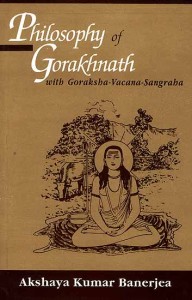
MAHAYOGI YOGACHARYA GURU GORKHNAHT JI AADESH AADESH .
BY MR . VISHAWAJEET SING JI
> HATHA YOGA AND THE MEANING OF TANTRA <
AADESH AADESH ,
MAHAYOGI ,YOGACHARYA ,GURU GORKH NATH JI
However, great Yogis such as Gorakshanath are following the system of Sadanga Yoga which has been stated by him in his book Goraksha Paddhati 1.7. This System avoids Yamaand Niyama. The justification given by those Yogis is that if you obtain mastery in meditation, your whole lifestyle gets changed in such a way, that you automatically start following the Yama and Niyamawhich are the necessary rules and individual rules of conduct respectively. These six aspects of Yoga are:
- Physical Postures
- Pranayama
- Pratyahara
- Dharana
- Dhyana
- Samadhi
2. According to the Nath Cult it is most important that the aspirant should purify his body completely. This has been stated in detail in Gheranda Samhita l.10-11-12. This is a total purification of all important and vital organs of the body such as stomach, small intestines, large intestines, nasal passage, food pipe, eyes, cars, throat, etc. After this the cult says that the aspirant is in a position to undertake all the steps of Yoga. In Patanjali’s Yoga Sutras this preparation of initial background is not mentioned.
3. The next step (in other Yoga systems) is the learning of physical postures. However, after learning all the important postures, the aspirant has to practise the most essential posture viz. Siddhasana or Vajrasana. For all the future Sadhanas this is considered to be the basic and important posture. The detailed description of this posture is given by Jnaneshvara in his sixth chapter of Jnaneshvari and also by a number of books of Nath Cult. They say that this posture is a must for all the aspirants. However, Patanjali says that you can sit in any convenient posture you like. Hence he gives the Sutra „Sthira-sukham asanam.“
4. The importance of a Guru or Master is maximum in Nath cult. Their every book or Shastra starts by remembering or bowing with great reverence and respect to the Guru Adinath or Shiva or Shankara. Jnaneshvari also starts like this by saying „Om Namoji Adya.“ This importance is not given to Guru in Patanjala Yoga Darshana.
5. The Nath cult says that the human body consists of certain most essential centres or vital points and voids (Akasha). (8) Every aspirant has to know and understand these things. They say that one who is not aware of these essential centres is not a Yogi. They are six Chakras, sixteen vital points, two Laksyas (concentration points), five voids, all situated within the human body. Such type of discussion is not found in Patanjala Yoga Darshana.
6. Nath cult says that the human body is just like a beautiful house which is having nine doors. It is formed out of five essential elements and each element is having its own deity. The nine openings are two eyes, two nostrils, two ear holes, mouth, excreta outlet, and sex organ. The deity of Earth is Brahma, of water is Vishnu, of fire is Rudra, of air is Ishvaraand of space is Sadashiva. Every aspirant has to understand these things. In Patanjala Sutras we do not find this.
7. The Nath Panth, in their various books as mentioned above, gives a detailed description of the seven chakras, their exact location in the body, their properties and functions etc. Jnaneshvara has not given the description of these chakras for the reason that he wanted to restrict his interpretation to the verses of Bhagavad-Gita. At the base of the spinal cord and at the centre of the line which connects sex organ and the excreta outlet is situated the first chakra which is known as Muladhara Chakra. Slightly above the sex centre and below the naval centre the second chakra is situated which is known as Svadhisthana Chakra. The third is situated near the naval centre and is called Manipura. The fourth one is situated near the heart centre and is known as Anahata Chakra. The fifth is situated at the throat centre and is known as Visuddha Chakra. It must be noted that all these chakras are situated in the Shushumna Nadi which passes through the spinal cord, which again passes through Vertebral Column. These are extremely subtle points and may not be structural and cannot be located by any sophisticated instrument available. These were actually ‚observed‘ and seen by the great Rishis in the stage of Samadhi. Here come the limitations of modern science. The sixth chakra is situated on the forehead and between the centre of the two eyebrows. This is known as Ajna Chakra. The seventh and the last chakra is situated in the centre of the brain in its uppermost portion. Patanjali does not mention any such thing in his Yoga Sutras.
8. According to Nath Cult there are 72.000 nerves in the body of human beings. Out of these ten Nadis are important. Out of these three are most important. They are known as Ida, Pingula and Shushumna. Ida is known as Chandra Nadi and is passing through the left side of the vertebral column. Pingula is known as Surya Nadi and is passing through the right side of the vertebral column. Shushumna Nadi is passing through the spinal cord and is known as Agni Nadi. Patanjali’s Yoga Sutras do not mention all this. He does mention a few Nadis like Kurma Nadi. But the detailed description is absent.
9. The concept of Prana has been studied in maximum details in Nath Cult. They say that in the human body there are ten different types of air or Vayus , which are known as Prana, Apana, Samana, Udana, Vyana, Naga, Kurma, Krikala, Devadatta and Dhananjaya. Each one is situated in a specific part of the body. Each one is having specific purpose and function in the body. When we take the air inside our body, it gets bifurcated into ten branches. This is just like a stream of water which starts from the Himalayan Mountains and gets bifurcated into several branches and each branch becomes a river and is given a separate name. Present medical science is not in a position to locate these ten different types of airs. However, our ancient Yogis have actually ’seen‘ these different streams of air inside our body. This type of description is not found in Patanjala Sutras.
10. When we breathe in there is a subtle sound which is known as ‚So‘ and when we breathe out there is a subtle sound which is known as ‚Ham‘. Everyone can experience this with slight practice. This sound of ‚Soham‘ is continuously going on with every breathing. In a period of one day, that is twenty-four hours, we take 21.600 breathings. That means this type of sound which is known as Mantra, is being continued in our body for that many number of times (21.600). If the aspirant observes this mentally and consciously, this becomes a great Sadhana. This Sadhana is being given very great importance in the Nath Cult. This is not found in Patanjala Yoga Sutras (PYS).
11. The most important aspect of the Yoga Sadhana of Jnaneshvara is the activation of the Kundalini Shakti. This is a Tantric Sadhana of the Nath Cult. Jnaneshvara has given a detailed account of this process in his sixth chapter. This is a practical application of the philosophy of Nath Panth. They say that the whole universe is created out of the energy of Shiva or Mahashiva or Adinatha. They call it Shakti or cosmic energy. This energy is occupying the whole universe. The smallest portion of this energy is known as Kundalini, and the energy which is present in the entire universe is known as Maha Kundalini. This energy is present in human beings in potential form (Supta Shakti). The Yogis who have experienced this energy, say that this is like a serpent and is situated at the end of the Shushumna Nadi in a coiled form, in three and a half coils, position. This also is in line with their philosophy which says „Bramhandi te Pindi“. This means that whatever exists in the universe also exists in the human being in the subtle form. Nath Cult and their great masters like Gorakshanath have devised various ways and means to activate this energy. Saint Jnaneshvara has described one method of activating this energy. This method has been stated in almost all the books of Hatha Yoga and Natha Panth and some Upanishads. The detailed description is available in the sixth chapter of Jnaneshvari.
This energy can also be activated by Mantra Yoga, Laya Yoga and Bhakti Yoga. That is why we find in Jnaneshvari all these systems of Upasana.
The ultimate stage of realisation or Moksha as per this colt is the union of Shakti with Shiva. Hence the aspirant initiated in this cult has to activate this energy and allow this energy to go through all the six chakras gradually. The place of Shiva is considered to be in the last chakra which is known as Sahasrara. In the ultimate stage, Sadhaka has to transfer this energy to this last chakra. This is supposed to be the point of union of Shakti with Shiva. One who is successful in this process, is supposed to be a great Yogi. A number of spiritual powers known as siddhis are at his disposal in that stage. A number of examples are available in the ancient Shastras about the Yogis, who were successful in obtaining this highest stage. Jnaneshvara had experienced the above union with Shiva and hence he is known as Maha Yogi. In PYS we do not find anything about Kundalini Shakti.
12. In Nath cult there is a great importance of a Gun or Master. He is given the same importance as is given to their ultimate Guru Adinath. That is why Jnaneshvara is giving maximum importance to his Guru Nivrittinath and is mentioning his name in Jnaneshvari at a number of places. Not only that, he gives the entire credit of writing this book to Nivrittinath. Their philosophy says that the aspirant can get the ultimate experience of truth or Shiva only with the continuous guidance of Guru or the Master. We find that every book of Nath Panth starts after bowing to Guru.
13. In this cult we find a mystic and esoteric act of the transfer of spiritual energy from the master to the initiated aspirant and the act is known as Shaktipata. With the tremendous powers of the master, he can activate the Kundalini energy of the disciple. This transfer, he can do by touching a specific part of his body or simply by looking at him. This transfer of energy can be done on the aspirant who is at a great distance from the master. This is a peculiar mystical act. After the transfer of energy, the aspirant experiences a number of supernatural things, a tremendous flow (of liquid) light, etc. However, those scholars who are really anxious, should go through the book Awakening of Kundalini written by Pandit Gopi Krishna, who had undergone all these experiences before about twenty-five years in Kashmir. The concept of Shaktipata is not found in PYS.
14. This cult gives a great importance to the practice of certain physical postures known as Mudras. They are useful in meditation and also in the activation of Kundalini energy and the six chakras. Hence every aspirant has to learn these Mudras. The ancient texts say that such Mudras arc twenty-five. Out of these ten are most important. With the practice of Mudras the aspirant is in a position to get rid of any and every disease and can acquire a number of supernatural powers. Because of these multiple advantages, the aspirant is taught these postures and afterhe achieves this experience, he is taught Pranayama. Mudras arc nowhere mentioned in PYS.
15. There is a difference between the Dhyana-meditation of Patanjali and Jnaneshvara. Patanjali gives the definition of Dhyana as per Sutra No. III.1 and III 2 which are as under. The aspirant has to concentrate on specific or vital part of the body or on some external point. This process is known as Dharana. When the aspirant gets success in the concentration on that particular point, for a sufficiently long time, it becomes a Dhyana. For the concentration on that particular point, the aspirant has to use his mind. However, in Kundalini Yoga, the aspirant has not to use his mind at all. He has to practise Kumbhaka, wherein the function of mind totally stops. Instead of concentrating on any particular point, the aspirant has to activate the Kundalini energy. This is a much superior way. This opinion has been confirmed by Sir John Woodroffe, in his book The Serpent Power on page No. 314 and 315 of the eleventh edition, which the learned scholars and philosophers can refer to any time.
16. Patanjali gives a broad division of Samadhi, which is termed as SamprajnataSamadhi and Asamprajnata Samadhi. However, the stage of Samadhi has been studied in details by the Nath cult and which is followedby Jnaneshvara in toto. Nath cult has categorised Samadhi in six types which are known as I ) Dhyana Yoga Samadhi, 2) Nada Yoga Samadhi, 3) Rasananda Yoga Samadhi, 4) Laya yoga Samadhi, 5) Bhakti Yoga Samadhi, and 6) Raja Yoga Samadhi. How each Samadhi can be experienced is also discussed in details. Scholars and philosophers can refer chapter seven of Gheranda Samhita which gives the entire description.
To conclude, I would like to state that both these systems of Yoga are different. The reason is obvious. Their philosophical base is altogether different. That is why the Yoga of Nath Panth accommodates Hatha Yoga, Kundalini Yoga, Mantra Yoga, and Bhakti Yoga. This Yoga Philosophy is therefore multi-dimensional. Besides the results here are very fast. This has been promised by Gorakshanath in his book. However, it is advisable that the practices of this Yoga should be undertaken under an able and experienced master.
To end the paper, I would like to quote the verse No. IV.114 from Hatha Yoga Pradipika. It says that till you are not in a position to activate the Kundalini energy, till you are not in a position to have perfect control over your pranic force, till you are not in a position to clear the path of Shushumna Nadi, all your knowledge is external, futile and full of ego. It is only an exercise of talking and nothing else. Hence he says that this is a process which has to be experienced only.
References
- Jnanesvari by Sakhare Maharaj.
- Goraksa-paddhati by Gorakshanath.
- Gheranda Samhita – Commentary by Shree Swamiji Maharaj.
- Hatha-yoga-Pradipika by Shree Swatmarama Yogi
- Patanjala Yoga (Sutra) Pradipa by Swami Omananda Tirtha.
- Patanjala Yoga Darsana by K.K. Kolhatkar
- Yoga Yajnavalkya
- Siddha-Siddhanta-Paddhati by Gorakshanath
- Shiva-Samhita – Commentary by Dr. K.R. Joshi
Dein Ayurveda Net, > svadhyaya < , Articles:
PRIME TREATMENTS IN AYURVEDA
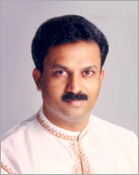
Dr. E. Shaji Raj, www.punarjanis.com
> PRIME TREATMENTS IN AYURVEDA <
Centuries ago, the enlightened masters, in search of spiritual solace, composed the Ayurveda, for the welfare of humanity. According to the scriptures, the human body is made up of 72000 channels connected to the seven spiral energy centers, the diseases of body and mind, which in turn block the path to spiritual enlightenment. The Panchakarma treatment aims at cleansing these channels, pacifying the disease and nourishing the body. It provides longevity, immunity against the disease, whereas in ancient times Yoga, Astrology, Tantra, and Ayurveda were practiced not for longevity but as an ultimate path to enlightenment.
In those ages Ayurveda and self-realisation were cognate and the people held this science in veneration. In the present world it is seen as merely a tool to cure human ailments. More over the practitioners of Ayurveda were Yogis, who would hold the stretched arms of the patients in their hands locate the pulse points and close their eyes as if in a deep trance. Seconds later, they would recount the diagnostic findings one by one. They never had any clinical laboratory or any other technological devices. The innate propensity of certain punarjanis were so splendid that it could work wonders to cure the diseases.
The physician:
Inspired by the findings of the Ayurveda masters we have formulated a system of treatment at ‚Punarjanis‘ bringing the ancient teachings to the limelight in an attempt to serve humanity. We focus on patients with chronic intractable ailments where routine medicine is only palliative.
Dr. E. Shaji Raj, a disciple of Bhramashri Parabattaraka Ananganandanathan Padathirtha, completed his > BAMS < from Madras University. Hailing from a family of traditional Ayurvedic physicians, he has been doing active research in the field of healing for the past 16 years – primarily related to raising energy from the lower center of the body to the higher center. He is one among the few ayurvedic physicians around the world who practice pulse reading and panchakarma treatment.
Incorporating the philosophy and the gist of Ayurveda with the root idea of Tantra and Yoga, the final result is not just cure, but a sea change – a path to enlightenment and bliss. The results have been amazing – an enlightened mind in a sound body.
Adi Shankara:
Adi Shankara (Malayalam:ആദി ശങ്കരന്, DevanÄ�garÄ�: आदि शङ्कर, Ä�di Śaṅkara, pronounced [aːd̪i ɕaŋkərə]); (788 CE – 820 CE), also known as Śaṅkara BhagavatpÄ�dÄ�cÄ�rya and Ä�di ŚaṅkarÄ�cÄ�rya, was an Indian philosopher who consolidated the doctrine of Advaita Vedanta, a sub-school of Vedanta. His teachings are based on the unity of the soul and Brahman, in which Brahman is viewed as without attributes. He hailed from Kalady of present day Kerala.
Shankara travelled across India and other parts of South Asia to propagate his philosophy through discourses and debates with other thinkers. He founded four mathas („monasteries“), which helped in the historical development, revival and spread of Advaita Vedanta. Adi Shankara is believed to be the organizer of the Dashanami monastic order and the founder of the Shanmata tradition of worship.
His works in Sanskrit, all of which are extant today, concern themselves with establishing the doctrine of Advaita (Nondualism). He also established the importance of monastic life as sanctioned in the Upanishads and Brahma Sutra, in a time when the Mimamsa school established strict ritualism and ridiculed monasticism. Shankara relied entirely on the Upanishads for reference concerning Brahman and wrote copious commentaries on the Vedic Canon (Brahma Sutra, Principal Upanishads and Bhagavadgita) in support of his thesis. The main opponent in his work is the Mimamsa school of thought, though he also offers some arguments against the views of some other schools like Samkhya and certain schools of Buddhism that he was familiar with.
Read More here : > HERE <
> Meet all Ayurveda Friends, Groups, Studies at facebook <
> Meet all Buddhism Friends, Groups, Studies at facebook <
> Meet all Hinduism Friends, Groups, Studies at facebook <
> Meet FREE visa to india for MBA , degree Programs, it jobs at fb <
> Meet Vedanta Studies, Friends, Yoga, Int. Society, Groups at fb <
Sankirtan Padayatra at Sylhet in Bangladesh.

> BHAGAVAD-GITA ONLINE (free) <
> GAURANGA TV – SRI PRABHUPADA VIDEO COLLECTION <
To celebrate the auspicious occasion of Lord Chaitanya’s 500th anniversary of Sannyasa, ISKCON Bangladesh invites devotees from all over the world to participate in Bangladesh Sankirtan Padayatra. ISKCON Bangladesh will conduct the Sankirtan Padayatra from 25th of October 2009 till 18th January 2010. ISKCON Bangladesh Co GBC H. H. Prabhavisnu Swami will inaugurate the Sankirtan Padayatra and participants will include other ISKCON GBCs and sannyasis such as, H.H. Jayapataka Swami, H.H. Bhakti Charu Swami, H.H. Subhag Swami, H.H. Lokanath Swami, H.H. Bhakti Purusattama Swami, H.H. Gauranga Prem Swami and H.H. Bhakti Siddhanta Swami.
Local organizers are arranging varieties of programs for inclusion in the Bangladesh Sankirtan Padayatra. Street hari namas processions, cultural programs with Bengali Vaisnava stage drama, lectures, discussions and video
presentations will all be included. Free prasadam distribution will be arranged throughout the entire program for all devotees and visitors to honour. In addition to all this, world famous Bengali kirtan and bhajan singers will abundantly showers a constant downpour of nectar, throughout the Padayatra, which will be tasted by all participants.
Many significant Vaisnava thirtas of Bangladesh will be visited along the Sankirtan Padayatra such as, the birth place of Sri Jaganatha Misra & Saci Devi , Sri Pundarik Vidyanidhi Dhama, Sri Rupa & Sanatana Smrti Thirtha (the birth place of Sri Rupa & Sanatana Goswamis) and the birth place of Srila Narottama Dasa Thakura etc. To conclude the Bangladesh Sankirtan Padayatra on the 15th of January, a huge harinama procession with 500 mdangas, will resound throughout the streets of Dhaka, the capital City of Bangladesh, wherein Vaisnavas from around the world will embrace their Bengali brothers and together loudly proclaim the names „Jaya Sacinandana Gaura Hari!“. ISKCON Bangladesh enthusiastically invites you to come and inundate the holy land of Bangladesh with the special mercy of Sri Caitanya Mahaprabhu which will flow abundantly during this special 500th anniversary festival.
ISKCON Bangladesh promises you an experience you will never forget! Hare Krishna.
For further information contact Nabadwip Dwija Gauranga Das Brahmacari ISKCON Bangladesh Co-Director.President Iskcon Sylhet
> Meet ISKCON Groups, Friends, Yoga, Studies at facebook <
> Meet Sri Prabhupada, Friends, Groups, Studies at facebook <
> Meet Bhagavad-Gita, Groups, Friends, Studies at facebook <
KARMA, KARMA YOGA, GODs GRACE
> A. C. Bhaktivedanta Swami Prabhupada <
> KARMA YOGA, – Sukadev Bretz <
armany akarma yah pasyed akarmani ca karma yah
sa buddhiman manusyesu sa yuktah krtsnakarmarkrt
He, who sees inaction in action, and action in inaction, is wise among men; he is a Yogi who has accomplished all action
Im strengen Sinn der Worterklärung bedeutet «Karma» : Handlung.
Die vedischen (alt-indischen) theologischen Schriften, wie die Bhagavad-Gita, führen diesen Begriff noch weiter aus, indem sie zwischen drei Arten von Handlungen unterscheiden: Karma, Vikarma und Akarma. In dieser tiefergehenden Unterscheidung werden mit dem Begriff «Karma» Handlungen bezeichnet, die eine angenehme Rückwirkung erzeugen.
Der Begriff «Vikarma» bezieht sich auf Handlungen, deren Wirkungen als Leid empfunden werden. Der Karma-Kandha Teil der Veden unterscheidet diese zwei Arten der Handlungen entsprechend den in den Veden zu findenden moralischen und ethischen Richtlinien als glückbringende und leidbringende Tätigkeiten. Dem Tun beider Kategorien ist gemeinsam, dass es Bindung im Kreislauf der Wiedergeburt erzeugt.
Die dritte Art von Handlungen werden «Akarma» (Nicht-Handeln) genannt, das heisst, sie erzeugen weder angenehme, noch leidvolle Wirkungen, sondern verursachen durch ihren Bezug zu der dieser irdischen Welt zugrundeliegenden göttlichen Welt, keine „materielle“ Wirkung, die in Form einer Reaktion «geerntet» werden müsste. Als Akarma wird grundsätzlich alles Tun bezeichnet, das in Gott, Ursprung, Natur, gründet. In der Bhagavad-Gita wird wie folgt darauf verwiesen:
«Jemand, der nicht motiviert ist, die Früchte seiner Handlungen zu geniessen, befreit sich schon in diesem Leben von guten (karma) und schlechten Taten (vikarma). Beschäftige dich deshalb auf dem Pfad des selbstlosen Handelns, denn solches Buddhi-yoga, die Ausgeglichenheit im selbstlosen Handeln, ist bestimmt die wahre Kunst des Handelns.» (2.50)
Über den rein wörtlichen Gehalt hinaus, schliesst der Beriff «Karma» auch die Folgen des Tuns ein. Entsprechend den Handlungen werden Wirkungen erzeugt, die auf den Handelnden zurückfallen.
Da niemand nur «gut» oder nur «schlecht» handelt, sind auch die auf den Verursacher zurückfallenden Wirkungen in unterschiedliche Verhältnisse von Genuss und Leid aufgeteilt. Dies wird dann oft als sogenanntes gutes oder schlechtes Karma oder einfach nur als «karmische Reaktionen» bezeichnet.
Dieselbe Thematik noch ein wenig vertieft:
Auch die westliche Wissenschaft kennt das Prinzip der Kausalität aller Aktionen und Ereignisse im Universum, wonach es für jede Erscheinung in dieser Welt, eine korrespondierende Ursache gibt.
Der Veda beschreibt seinerseits ein Gesetz von Ursache und Wirkung, welches die Wirkung an die Ursache knüpft und zwar sowohl auf der grob- wie auch feinstofflichen Ebene unserer weltlichen Existenz: das Gesetz des Karma.
Im strengen Sinn der Worterklärung bedeutet der Begriff Karma: Handlung.
In den verschiedenen Erklärungen von Guru (Lehrer), Sadhu (Heiligen) und Shastra (heiligen Texten) wird dieser Begriff noch weiter ausgeführt. Über den rein wörtlichen Gehalt hinaus, schliesst der Beriff Karma auch die Folgen des Tuns ein. Dabei erzeugen die Handlungen nicht nur Wirkungen, welche die Umwelt beeinflussen, sondern wirken auch auf den Handelnden selbst zurück.
Als Grundeinsicht der meisten vedischen Karmalehren gilt daher das Verständnis:
„Des Menschen Wesen, seine Natur und seine Lebensumstände sind das Ergebnis seiner eigenen inneren und äusseren Betätigungen, nicht etwas Zufälliges und Unerklärliches. Er ist das, wozu er sich selbst gemacht hat. Jeder Mensch erntet, was er sät. Von dem, was er tut, hat er seinen Vorteil; für das, was er tut, leidet er.“ (Die Idee der Reinkarnation in Ost und West, Diederichs 1996, S. 66).
Damit verliert der Zufall seine Grundlage und erhält stattdessen eine sehr wörtliche Bedeutung: etwas, was einem aufgrund des eigenen vergangenen Tuns zu-fällt.
Seit unvordenklicher Zeit handelt das Lebewesen in der materiellen Welt und geniesst oder erleidet die Reaktionen auf seine Handlungen. Es sind seine Handlungen, die zu einer Wanderung von einem materiellen Körper zum anderen führen.
Da niemand nur gut oder nur schlecht handelt, sind auch die auf den Verursacher zurückfallenden Wirkungen in unterschiedliche Verhältnisse von Genuss und Leid aufgeteilt. Dies wird dann oft als sogenanntes gutes oder schlechtes Karma oder einfach nur als karmische Reaktionen bezeichnet.
Grundsätzlich unterscheidet der Veda drei Arten von Handlungen: Karma, Vikarma und Akarma.
– Karma ist das Tun, das angenehme Wirkungen erzeugt.
– Vikarma bezieht sich auf Handlungen, deren Wirkungen als Leid erfahren werden.
Der Karma-Kandha Teil der Veden unterscheidet diese zwei Arten der Handlungen entsprechend den in den Veden zu findenden moralischen und ethischen Richtlinien als glückbringende und leidbringende Tätigkeiten. Doch beide dieser Kategorien des Tuns werden als Knechtschaft bezeichnet, da sie Bindung an den Kreislauf der Wiedergeburt erzeugen (karma-bandhana).
– Die dritte Art von Handlungen wird Akarma (Nicht-Handeln) genannt.
Das heisst, sie erzeugen weder angenehme, noch leidvolle Wirkungen, sondern verursachen durch ihren Bezug zu der dieser irdischen Welt zugrundeliegenden göttlichen Welt, keine Bindung an diese Welt. Grundsätzlich ist damit alles Tun gemeint, das in Gott, Natur, Ursprung, gründet.
Wie bereits aus den Anfangskapiteln der Bhagavad-gita hervorgeht, kann das Lebewesen nicht einfach dadurch vom Karma frei werden, dass es sich von Tätigkeit fernhält. Im Gegenteil: Der Veda beschreibt die Eigenschaft der Seele als ewig und unverrückbar aktiv. Freiheit von der grossen Kette des Karma kommt durch Wissen.
„So wie das lodernde Feuer Brennholz zu Asche verwandelt, o Arjuna, so verbrennt das Feuer des Wissens alle Reaktionen auf materielle Tätigkeiten (sarva-karmani) zu Asche.“
Tun, das in diesem Wissen gründet, beschreibt die Bhagavad-gita wie folgt:
„Jemand, der nicht motiviert ist, die Früchte seiner Handlungen zu geniessen, befreit sich schon in diesem Leben von guten (karma) und schlechten Taten (vikarma). Beschäftige dich deshalb auf dem Pfad des selbstlosen Handelns, denn solches Buddhi-yoga, die Ausgeglichenheit im selbstlosen Handeln, ist bestimmt die wahre Kunst des Handelns.“ (2.50)
In einem ersten Schritt bezieht sich selbstloses Tun oder im Wissen zu handeln, welches das Karma zu Asche verbrennt, darauf, dass das Lebewesen sich zumindest theoretisch seiner wesensgemässen Stellung als der ewiger Diener des Höchsten bewusst wird. Das Subjekt ist das Zentrum. Das Objekt (Lebewesen) steht immer in einer Abhängigkeit zu diesem Zentrum. Erkennt das verkörperte Lebewesen seine wesensgemässe Stellung und handelt in diesem Bewusstsein, kann es alles vergangene, gegenwärtige und zukünftige Karma transzendieren.
So erklärt das Darada-pancaratra, die Kunst des karma-yoga sei hrsikene hrsikesa-sevanam: „Dem Herrn der Sinne mit seinen eigenen Sinnen zu dienen“.
Es ist die Aufgabe des Lehrers, seine Schüler diese schwer fassbare Kunst des Akarma oder der Aktion ohne Reaktion zu lehren. (karma + vikarma = akarma)
> Meet many Srila Prabhupada Groups, Friends at facebook <
> Meet many BAGHAVAT GITA Groups, Friends, Studies at facebook <
> Meet many ISKCON Groups, Friends, Studies, Education at facebook <
PATANJALI – DIE WURZELN DES YOGA
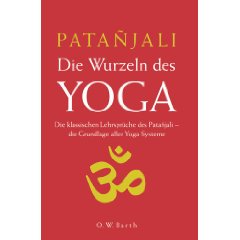
Die klassischen Lehrsprüche des Patanjali
von Bettina Bäumer
> YOGA & AYURVEDA von Vinod Verma <
Patanjalis Yoga-Sutras und ihre Anwendung auf Ayurveda
Patanjali (Sanskrit, पतञ्जलि, Patañjali, [pʌtʌɲʤʌlɪ]) war ein indischer Gelehrter, der die heute noch vollständig überlieferten Yoga-Sutras verfasst haben soll. In der indischen Mytholgie gilt er als Inkarnation des Schlangenkönigs Shesha. Über das Leben von Patañjali ist jedoch nichts bekannt, auch nicht wann er gelebt hat. Es ist nicht einmal sicher, ob er eine historische Persönlichkeit war. Indische Tradition setzt ihn mit dem Grammatiker gleichen Namens, der im 2. Jahrhundert vor Christus lebte, gleich. Da der Wortschatz des Grammatikers und des Schreibers jedoch stark von einander abweichen, gehen Indologen davon aus, dass es sich nicht um die gleiche Person handelt. Vielmehr sind sie aufgrund bestimmter Formulierungen, die sich auch im Spätbuddhismus finden, der Ansicht, das Werk sei im 4. oder 5. Jahrhundert nach Christus entstanden.
Wörtlich übersetzt bedeutet Sutra „Faden“. Das Yoga-Sutra ist also gewissermaßen ein Leitfaden für Yoga, der anders als die Bhagavadgita keine Rahmenhandlung besitzt und auch nicht gesungen wurde. Das Yoga-Sutra von Patañjali besteht aus 195 Sanskrit-Versen, in denen in hochkonzentrierter Form die Essenz des Yoga-Weges gebündelt ist. Es ist eine der ältesten Überlieferungen der Yoga-Tradition. Diese Form des Yoga wird als Raja Yoga oder Ashtanga Yoga (achtgliedriger Yoga) bezeichnet.
Kurzbeschreibung
Diese klassischen Lehrsprüche bilden die geistige Grundlage aller Yogasysteme. Sie stammen aus Überlieferungen, die wahrscheinlich im 2. Jahrhundert v. Chr. von Patañjali aufgezeichnet wurden. Die Vielfalt der Schulen und Richtungen, die sich im Laufe der Jahrhunderte entwickelt haben, geht auf diese älteste Quelle zurück. Die 195 prägnanten Sentenzen weisen den »königlichen Weg« zur vollkommenen inneren Befreiung durch rechte Erkenntnis. Er führt schrittweise , ohne Askese und gewaltsame Unterdrückung der Denkvorgänge, zum Verständnis der Wirklichkeit. Im Yoga leben heißt, unmittelbar, von Augenblick zu Augenblick, ohne hemmende Bindung an die Vergangenheit, ohne eingeschliffene Gewohnheiten oder eine überkommene Weltanschauung leben. P.Y. Deshpande, ein bekannter Schriftsteller und Publizist, hat sich über vierzig Jahre lang in Theorie und Praxis mit Yoga beschäftigt. Seine Einsichten, die Früchte dieser langjährigen Erfahrung, bilden zusammen mit den von Bettina Bäumer aus dem Sanskrit übertragenen Sutren ein unentbehrliches Standardwerk auf dem Gebiet des Yoga.
A G A M A
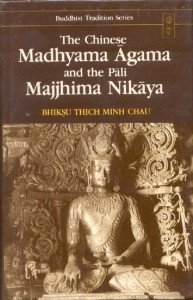
> The Chinese Madhyama Agama & the Pali Majjhima Nikaya <
> AGAMA IN BUDDHISM, JAINISM, HINDUISM <
A G A M A
By Jayaram V
The word „agama“ means authoritative scripture. It was used by > Panini < , the Sanskrit grammarian, as a linguistic term, to describe the formation of certain words. Tantric and Saiva tradition recognizes the agamas as the most authoritative and sacred texts on the methods of worshipping Saguna Iswara or the Brahman with qualities. In a limited sense the agamas are tantric texts containing the principles and practice of Saivism, presented in the form of a teaching by Lord Siva to His consort Parvathi. in contrast, the nigamas, another branch of sacred litetature, depict Parvathi as the teacher and Siva as its recipient. According to the Tantric tradition, the Vedas are nigamas.
Scholars believe that the earliest Agamas were composed during the later Vedic period, when the Vedic rituals were on the decline and Saivism, Vaishnavism and other religious sects were gaining ground. Not all agree with this contention. Some believe the earliest agamas to be much older than the Vedas. There is also an argument that some of the Upanishads and even some portions of the Bhagavadgita were renditions of preexisting agamas. Followers of Siva consider these texts superior to the Vedas. Unlike the Vedas, the Agamas are meant for all castes and sections of society, including women. While the many agamas belong to Saivism and recognize Siva as the Supreme deity, there are also Vaishnava and Shakti agamas which recognize Vishnu and Shakti respectively as the Supreme Iswara.
There is no unanimity as to the actual number of the agamas. Based upon who is recognized as the principal deity, the agamas are divided into Saiva, Vaishnava and Shakti or Tantra agamas. The Pancaratra Agamas and the Vaikanasa Agama belong to the Vaishnava tradition. The Saiva agamas, which contritubuted to the popularity of the southern school of Saiva Siddhanta philosophy and northern school of the Pratyabhijna system of Kashmir Saivism, are divided two distinct categories, namely the 28 Saiva Siddhanta Agamas and 64 Agamas belonging to both the Nakulisa Pasupatha and the Kashmiri Trika schools of Saivism. The > Kaula < , > Mishra < and> Samaya agamas < (and siddhanta texts) are considered to be part of the Shakti tradition. The Vaishnava agama is further divided into Pancharatra and Vaikanasa Agama. The smartas, who acknowledge the Vedas as the supreme and follow the Vedic tradtion, recognize the Agamas, but don’t necessarily adhere to them. In the Malay languages the word Agama literally means religion. The Agamas are also sometimes known as Tantras.
Buchtipp: Bettina Bäumer, Trika: > Grundthemen des kaschmirischen Sivaismus <
There is no unanimity as to what constitue the 28 Agamas of the Saiva Siddhanta schools. According to one classification, of the 28 agamas, ten represent the school of Advaita (monism) or Sivabheda and the rest the school of Vishishtadvaita (qualified monism)or Rudrabheda. The 28 Agamas are listed below:
saundaryalahari-flood of beauty
The Saundaryalahari
The Saundaryalahari; or, Flood of Beauty – traditionally ascribed to Sankaracarya (vedanta, siehe zB. Beitrag Veden Übersicht, samkhya/vedanta, Yoga Literatur), edited and translated by W. Norman Brown (Cambridge, Mass.: Harvard University Press, 1958).
Yoga, Tantra – Samkhya & Vedanta
Ein Überblick
Yoga, Philosphie, Literatur & Systeme
Samkhya & Vedanta
Nach dem vedischen Zeit, die mit der Abfassung der Upanishaden ausklingt, beginnt in Indien im ersten vorchristlichen Jahrtausend ein Zeitalter, in dem verschiedene Philosophenschulen populär werden. Eine dieser Schulen heißt Sâmkhya, wörtlich: das, was sich auf Überlegung, Berechnung, Aufzählung bezieht. Die Weltanschauung des Sâmkhya ist von radikaler Nüchternheit und verzichtet auf Vorstellungen von Gott und Schöpfer.
pashupata brahma upanishad
Das Yoga der Lichtphänomene & die radikal nondualistische Philosphie, bzw. die lichterfüllte Mystik des nachklassichen Yoga im indischen Mittelalter :
Die Pashupata Brahma Upanishad ist ein Shaiva Werk von 78 Versen in zwei Kapiteln. Sie leitet ihren Namen ab von den Anhängern Pashupatis – des Gottes Shiva dieses mal als Herr der „Tiere“ (pashu) oder versklavten Seelen. (Wir wissen ja bereits über die enormen Erscheinungsformen Shivas). Die Schrift fusst auf der Opfersymbolik der Brahmanen, die bereits den Veden ungemein tief verbunden waren und sind und stellt des Weiteren die Rezitation des hamsa-mantra als eine Form des inneren bzw. geistigen Opfers dar. Dieser Vorgang wird auch nada-anusamdhana, d.h. „Anwendung des (inneren) Tons“ genannt – ein mit den kanphata-yogins speziell verbundener Begriff, der auf der esoterischen Vorstellung von 96 „solaren Strahlenbündeln“ im Herzen beruht. Das sind leuchtende, im raum-& zeitlosen Selbst entspringende Verbindungslinien, über die das Göttliche im menschlichen Körper-Verstand-System schöpferisch intervenieren kann. „Solch okkulter Sachverhalt hinsichtlich des Absoluten findet sich nirgendwo sonst beschrieben“, meint der Text (1.25).
Weiters heisst es, die Befreiung sei nur für den yogin möglich, der über die Identität von hamsa als Klang mit hamsa als übersinnliches Selbst zu meditieren vermag.


